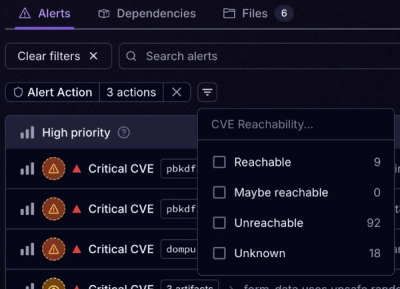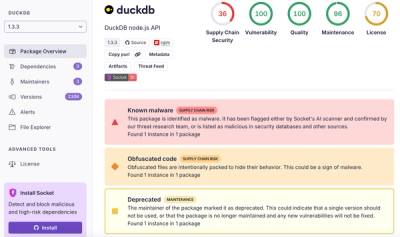
Product
Introducing Tier 1 Reachability: Precision CVE Triage for Enterprise Teams
Socket’s new Tier 1 Reachability filters out up to 80% of irrelevant CVEs, so security teams can focus on the vulnerabilities that matter.
lambert-db
Advanced tools
A Database abstraction layer for different DB Engines
This allows easy access to a database much like like accessing an object.
The library design facilitates exchanging the underlying database engine without changing your application code.
Also it only get's/set's the necessary data for the operations and not the whole table unlike quick.db.
npm i lambert-db
# or "yarn add lambert-db"
ES5 import
require("lambert-db");
or ES6 import
import "lambert-db";
Choose a database engine: MongoDatabase
At the moment there is only an implementation for MongoDB available, however I will add others. You can also implement your own database class and submit a pull request.
Every Database has an .init() method whose execution must be awaited before using the database.
class Database {
init (): Promise<any>;
destroy(): Promise<any>;
data : DatastoreInterface; // ES6 Proxy Object
}
To use the database, access the .data property and specify the path.
db.data.users.name // (the path for this example is users.name).
The below operations can then be called on the path:
get(projection?: Projection): Promise<any>; // returns a promise with the value for this path
first() : Promise<any>; // returns a promise with the first entry
last() : Promise<any>; // returns a promise with the last entry
random() : Promise<any>; // returns a promise with a random entry
delete() : Promise<boolean>; // deletes the value for this path
set(value: any) : Promise<boolean>; // sets the value for this path
exists() : Promise<boolean>; // checks if a value for this path exists
push(value: any) : Promise<boolean>; // pushes the value into the array for this path
All operations are asynchronous and return a promise which have to be awaited.
The return value of type Promise<boolean> indicates a successful operation.
await db.data.users.push({id: 1, name: "test", posts: [1,2,3] }) // this will insert this user object
await db.data.users.name.set("hello") // this will set the name hello for all users
await db.data.users.name.get() // this will return an array with the users names
await db.data.users.delete() // this will delete all users
The .get(projection?: Projection) function can optionally accept a projection parameter.
A Projection is a Key-Value Object of booleans that indicates whether these properties should be received.
type Projection = {
[index: string]: boolean;
};
var projection = { id: true, name: true}
For example, a database with a boards table that contains board objects like: { id: number, name: string, members: [], posts: [] } and only ids and names should be accessed.
The projection parameters can be used to specify multiple but not all properties to be retrieved e.g:
await db.data.boards.get({ id: true, name: true}); // This will only return the id and name of the boards
Filters can be used to get a specific card in the example above, by calling a property with .property(filter) when accessing a path.
A filter can be an object or a function which will be called for every entry in an array and can be specified for each property in a path.
await db.data.boards({id: 1}).get() // This will return the board with id: 1 and insert
await db.data.boards({id: 1}).posts({id: 0}).comments.push({author: 1, content: "test"}) // This will post a comment to board.id: 1 and post.id: 0
const { MongoDatabase } = require("lambert-db");
const db: Database = new MongoDatabase();
db.init().then(async () => {
let success = await db.data.users.push({ id: 0, roles: [] });
if (!success) throw new Error("couldn't insert new user");
let user = await db.data.users({ id: 0 }).get();
console.log(user);
success = await db.data.users({ id: 0 }).roles.push({ type: "admin", name: "test", permissions: 2 });
if (!success) throw new Error("couldn't add role for user");
console.log(await db.data.users.get({ id: true}));
success = await db.data.users({ id: 1 }).delete();
if (!success) throw new Error("couldn't delete user");
});
FAQs
A Database abstraction layer for different DB Engines
We found that lambert-db demonstrated a not healthy version release cadence and project activity because the last version was released a year ago. It has 1 open source maintainer collaborating on the project.
Did you know?

Socket for GitHub automatically highlights issues in each pull request and monitors the health of all your open source dependencies. Discover the contents of your packages and block harmful activity before you install or update your dependencies.

Product
Socket’s new Tier 1 Reachability filters out up to 80% of irrelevant CVEs, so security teams can focus on the vulnerabilities that matter.

Research
/Security News
Ongoing npm supply chain attack spreads to DuckDB: multiple packages compromised with the same wallet-drainer malware.

Security News
The MCP Steering Committee has launched the official MCP Registry in preview, a central hub for discovering and publishing MCP servers.